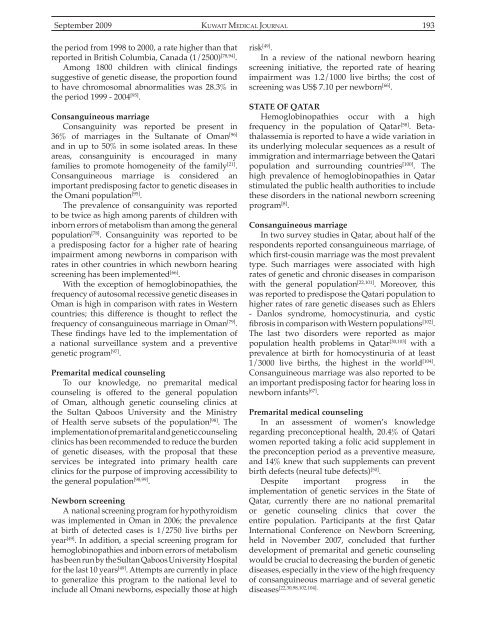Vol 41 # 3 September 2009 - Kma.org.kw
Vol 41 # 3 September 2009 - Kma.org.kw
Vol 41 # 3 September 2009 - Kma.org.kw
Create successful ePaper yourself
Turn your PDF publications into a flip-book with our unique Google optimized e-Paper software.
<strong>September</strong> <strong>2009</strong><br />
KUWAIT MEDICAL JOURNAL 193<br />
the period from 1998 to 2000, a rate higher than that<br />
reported in British Columbia, Canada (1/2500) [78,94] .<br />
Among 1800 children with clinical findings<br />
suggestive of genetic disease, the proportion found<br />
to have chromosomal abnormalities was 28.3% in<br />
the period 1999 - 2004 [95] .<br />
Consanguineous marriage<br />
Consanguinity was reported be present in<br />
36% of marriages in the Sultanate of Oman [96]<br />
and in up to 50% in some isolated areas. In these<br />
areas, consanguinity is encouraged in many<br />
families to promote homogeneity of the family [21] .<br />
Consanguineous marriage is considered an<br />
important predisposing factor to genetic diseases in<br />
the Omani population [95] .<br />
The prevalence of consanguinity was reported<br />
to be twice as high among parents of children with<br />
inborn errors of metabolism than among the general<br />
population [78] . Consanguinity was reported to be<br />
a predisposing factor for a higher rate of hearing<br />
impairment among newborns in comparison with<br />
rates in other countries in which newborn hearing<br />
screening has been implemented [66] .<br />
With the exception of hemoglobinopathies, the<br />
frequency of autosomal recessive genetic diseases in<br />
Oman is high in comparison with rates in Western<br />
countries; this difference is thought to reflect the<br />
frequency of consanguineous marriage in Oman [79] .<br />
These findings have led to the implementation of<br />
a national surveillance system and a preventive<br />
genetic program [97] .<br />
Premarital medical counseling<br />
To our knowledge, no premarital medical<br />
counseling is offered to the general population<br />
of Oman, although genetic counseling clinics at<br />
the Sultan Qaboos University and the Ministry<br />
of Health serve subsets of the population [98] . The<br />
implementation of premarital and genetic counseling<br />
clinics has been recommended to reduce the burden<br />
of genetic diseases, with the proposal that these<br />
services be integrated into primary health care<br />
clinics for the purpose of improving accessibility to<br />
the general population [98,99] .<br />
Newborn screening<br />
A national screening program for hypothyroidism<br />
was implemented in Oman in 2006; the prevalence<br />
at birth of detected cases is 1/2750 live births per<br />
year [49] . In addition, a special screening program for<br />
hemoglobinopathies and inborn errors of metabolism<br />
has been run by the Sultan Qaboos University Hospital<br />
for the last 10 years [49] . Attempts are currently in place<br />
to generalize this program to the national level to<br />
include all Omani newborns, especially those at high<br />
risk [49] .<br />
In a review of the national newborn hearing<br />
screening initiative, the reported rate of hearing<br />
impairment was 1.2/1000 live births; the cost of<br />
screening was US$ 7.10 per newborn [66] .<br />
STATE OF QATAR<br />
Hemoglobinopathies occur with a high<br />
frequency in the population of Qatar [58] . Betathalassemia<br />
is reported to have a wide variation in<br />
its underlying molecular sequences as a result of<br />
immigration and intermarriage between the Qatari<br />
population and surrounding countries [100] . The<br />
high prevalence of hemoglobinopathies in Qatar<br />
stimulated the public health authorities to include<br />
these disorders in the national newborn screening<br />
program [8] .<br />
Consanguineous marriage<br />
In two survey studies in Qatar, about half of the<br />
respondents reported consanguineous marriage, of<br />
which first-cousin marriage was the most prevalent<br />
type. Such marriages were associated with high<br />
rates of genetic and chronic diseases in comparison<br />
with the general population [22,101] . Moreover, this<br />
was reported to predispose the Qatari population to<br />
higher rates of rare genetic diseases such as Ehlers<br />
- Danlos syndrome, homocystinuria, and cystic<br />
fibrosis in comparison with Western populations [102] .<br />
The last two disorders were reported as major<br />
population health problems in Qatar [30,103] with a<br />
prevalence at birth for homocystinuria of at least<br />
1/3000 live births, the highest in the world [104] .<br />
Consanguineous marriage was also reported to be<br />
an important predisposing factor for hearing loss in<br />
newborn infants [67] .<br />
Premarital medical counseling<br />
In an assessment of women’s knowledge<br />
regarding preconceptional health, 20.4% of Qatari<br />
women reported taking a folic acid supplement in<br />
the preconception period as a preventive measure,<br />
and 14% knew that such supplements can prevent<br />
birth defects (neural tube defects) [50] .<br />
Despite important progress in the<br />
implementation of genetic services in the State of<br />
Qatar, currently there are no national premarital<br />
or genetic counseling clinics that cover the<br />
entire population. Participants at the first Qatar<br />
International Conference on Newborn Screening,<br />
held in November 2007, concluded that further<br />
development of premarital and genetic counseling<br />
would be crucial to decreasing the burden of genetic<br />
diseases, especially in the view of the high frequency<br />
of consanguineous marriage and of several genetic<br />
diseases [22,30,98,102,104].
















